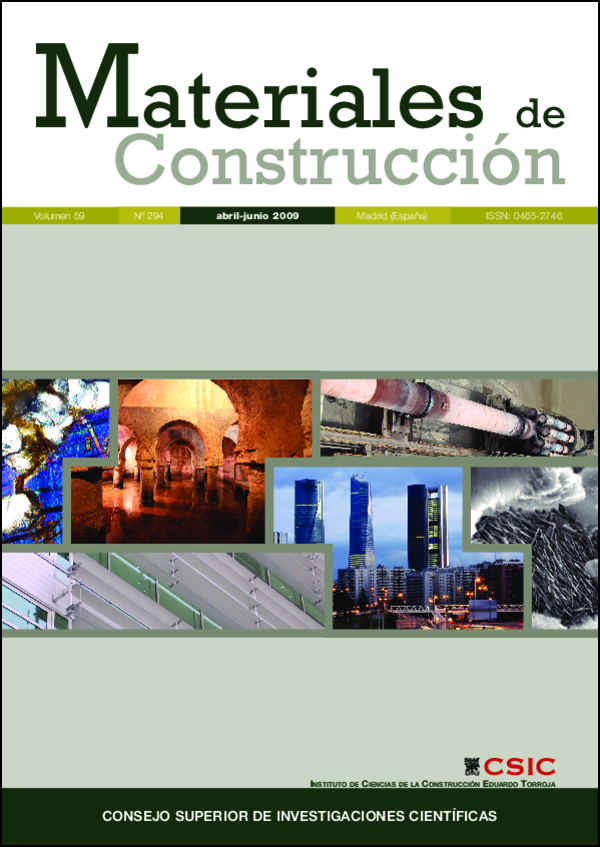Effect of ZnO; ZrO2 y B2O 3. Part II. Phase separation and clinker phase distribution
DOI:
https://doi.org/10.3989/mc.2009.46308Keywords:
Portland cement clinker, ZnO, ZrO2, B2O3, separation methodsAbstract
This study is a continuation of previous research which established the effect of the oxides ZnO, ZrO2 and B2O3, both separately and jointly, on clinkerization processes, as well as on clinker phase composition and morphology. A knowledge of the distribution of these elements in mineral phases is requisite to understanding which phases they affect and how. The present study aimed, then, to develop a suitable methodology for the selective separation of clinker phases and to ascertain how ZnO, ZrO2 and B2O3 are distributed in these phases when added to the raw mix in proportions of up to 2%. The optimal conditions for separating clinker phases with selective solutions (KOH-sucrose and CH3OHsalicylic acid) were established. These selective treatments proved to be insufficient in and of themselves to determine the distribution of ZnO and ZrO2 in the clinker phases. Consequently, the original clinkers had to be analyzed with SEM/BSE/EDX techniques to complete the study. The findings showed that ZnO and ZrO2 were fixed primarily in the C3A and C4AF present in the clinker, while B2O3 was taken up by the silicate phases.
Downloads
References
(1) Puertas, F.; Barba, A.; Gazulla, M. F.; Gómez, M. P.; Palacios, M. y Martínez-Ramírez, S.: “Ceramic wastes as raw materials in Pórtland cement clinker fabrication.• caracterization and alkaline activation”, Mater. Construcc., Vol. 56, nº 281 (2006), pp. 73-84. doi:10.3989/mc.2006.v56.i281.94
(2) Puertas, F.; García-Díaz, I.; Barba, A.; Gazulla, M. F.; Palacios, M.; Gómez, M. P. y Martínez-Ramírez, S.: “Ceramic wastes as alternative raw materials for the portland cement clinker production”, Cem. Concr. Comp., Vol. 30 (2008), pp. 798-805. doi:10.1016/j.cemconcomp.2008.06.003
(3) García-Díaz, I.; Puertas, F.; Gazulla, M. F.; Gómez, M. P. y Palacios, M.: “Effect of ZnO, ZrO2 and B2O3 on clinkerization process. Part I. Clinkerization reactions and clinker composition”, Mater. Construcc., Vol. 58, nº 292 (2008), pp. 81-99. doi:10.3989/mc.2008.45307
(4) Gutteridge, W. A.: “On the dissolution of the interstitial phases in Portland cement”, Cem. Concr. Res., Vol. 9 (1979), pp. 319-324. doi:10.1016/0008-8846(79)90124-8
(5) Treviño, F. y Blanco, M. T.: “Determinación de la composición mineralógica del clínker por microscopía cuantitativa, disolución de fases y difracción de rayos X”, Mater. Construcc., Vol., nº 190-191 (1983), pp. 103-114.
(6). Mander, J. E.; Adams, L. D. y Larkin, E. E.: “A method for the determination of some minor compounds in Portland cement and clinker by X-Ray Diffraction”, Cem. Concr. Res., vol. 4 (1979), pp. 533-544. doi:10.1016/0008-8846(74)90004-0
(7) Klemm, W. A. y Skalny, J.: “Selective dissolution of clinker minerals and its application”, XII Conferernce on silicate Industry and silicate sicence, Technical Report, Budapest (1977), pp. 77-32.
(8) Guagliang, X.; Wenx, H. I.; Zhongyuan, L. y Guangren, Q.: “The effect of ZnO on burning of Portland cement clinker in rapid heating-up burning”, 9th International Congress on the Chemistry of Cement, New Delhi (1992), pp. 372-378.
(9) Kakali, G.; Kasselouri, V. y Parissakis, G.: “Investigation of the effect of Mo, Nb, W and Zr oxides on the formation of Portland cement clinker”, Cem. Concr. Res., Vol. 20 (1990), pp. 131-138. doi:10.1016/0008-8846(90)90123-F doi:10.1016/0008-8846(90)90123-F
(10) Kakali, G.; Kasselouri, V. y Parissakis, G.: “Hydration and strength development of cement produced from raw mixes containing MoO3, Nb2O5, WO3 and ZrO2”, Cem. Concr. Res., Vol. 19 (1989), pp. 968-972. doi:10.1016/0008-8846(89)90110-5
(11) Ghose, A. y Barnes, P.: “Electron microprobe analysis of Portland cement clinker”, Cem. Concr. Res., Vol. 9 (1979), pp. 747-755. doi:10.1016/0008-8846(79)90070-X
(12) Harrisson, A. M.; Taylor, H. F. W. y Winter, N. B.: “Electron-optical analysis of phases in Portland cement clinker, with some observations on the calculation of quantitative phase composition”, Cem. Concr. Res., Vol. 15 (1985), pp. 775-780. doi:10.1016/0008-8846(85)90142-5
(13) Taylor, H. F. W.: “Cement Chemistry”, segunda edición (1997).
(14) Fernández Navarro, J. M.: “El Vidrio”, Sociedad Española de Cerámica y Vidrio, Editado por el Consejo Superior de Investigaciones Científicas, Madrid (2003).
Downloads
Published
How to Cite
Issue
Section
License
Copyright (c) 2009 Consejo Superior de Investigaciones Científicas (CSIC)

This work is licensed under a Creative Commons Attribution 4.0 International License.
© CSIC. Manuscripts published in both the print and online versions of this journal are the property of the Consejo Superior de Investigaciones Científicas, and quoting this source is a requirement for any partial or full reproduction.
All contents of this electronic edition, except where otherwise noted, are distributed under a Creative Commons Attribution 4.0 International (CC BY 4.0) licence. You may read the basic information and the legal text of the licence. The indication of the CC BY 4.0 licence must be expressly stated in this way when necessary.
Self-archiving in repositories, personal webpages or similar, of any version other than the final version of the work produced by the publisher, is not allowed.
















